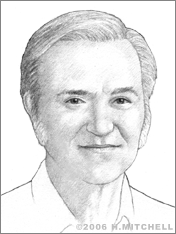Burt Rutan
Many of the most significant developments in private aircraft development over the last several decades may be attributed to aviation innovator, inventor, aeronautical engineer and entrepreneur Burt Rutan.
Born by the name of Elbert Leander Rutan, on June 17, 1943, in Estacada, Oregon, the family soon moved to Dinuba, Calif., where Rutan spent his childhood. His father, a dentist, was part-owner of a private airplane and his interest in flying helped to encourage all three of the Rutan children to become interested in the activity as well. Burt’s brother, Richard “Dick” Rutan, became an Air Force combat pilot and later ran his own aerobatic airplane company; his sister, Nellie, became a flight attendant.
Burt, meanwhile, developed an early passion for building model airplanes and earned his pilot’s license as a teenager, soloing for the first time in 1959. He entered California Polytechnic University, now the California Institute of Technology, from where he graduated third in his class in 1965 with a BS in aeronautical engineering. From there he became a test engineer with Edwards Air Force Base in Mojave, California, about 60 miles northeast of Los Angeles. He remained there until 1972 and conducted some 15 U.S. Air Force Flight Test programs.
In 1972, he accepted a post as director of the Bede Test Center for Bede Aircraft in Newton, Kansas, where he directed development of at least three types of aircraft. In 1974, he returned to Mojave and started his first company, Rutan Aircraft Factory, to build and sell his own private plane designs primarily to hobbyists. Most of these were two-seater aircraft; Rutan became adept at building lightweight, yet strong and powerful planes using composite materials. His first design was the Rutan VariViggen, a two-seat pusher with a canard in front, the canard would become a standard feature in many Rutan designs.
Rutan’s groundbreaking ideas lead him to develop craft unlike any others that previously existed; with RAF, he produced such planes as the VariEze (a do-it-yourself kit plane for hobbyists), the NASA AD-1, Defiant, Long-EZ, Grizzly, Solitaire, Catbird and Boomerang. He also pioneered non-stop, round-the-world airplane flights with his now-famous Voyager craft, which, piloted by Dick Rutan and Jeana Yeager, achieved a world record when it completed a nine-day, non-stop flight around the world in 1986.
By then, he had begun to take advantage of opportunities to build experimental craft for large clients such as the U.S. Air Force, NASA and a variety of aerospace companies. In 1982, he founded Scaled Composites to cater to this clientele. He developed dozens of craft through Scaled Composites, culminating in 2004 with SpaceShipOne, the world’s first successful craft designed for private spaceflight. SS1 exceeded an altitude of 328,000 feet twice within 14 days to win the $10 million Ansari X Prize, awarded on Oct. 4, 2004. In June of that year, SpaceShipOne officially became a spacecraft when it cracked the 62-mile mark for the first time, making its pilot Mike Melvill, the world's first civilian astronaut.
Rutan, with backing from former Microsoft executive and millionaire investor Paul Allen, developed SS1 to work with an airborne launch system, which allowed it to launch from the “White Knight” gull-wing turbojet launcher at up to 48,000 feet. SS1 is equipped with a “Care-Free” atmospheric re-entry concept that keeps it immune to accidents from inadequate flight control during that critical period. On re-entry it converts back to conventional reconfiguration, allowing it to make stable glides and runway landings.
Many expressed interest in bringing Rutan’s space vehicle concepts to commercialization. The high-profile success of SS1 helped him to seal a deal with Virgin Atlantic founder and aviation enthusiast Richard Branson to form the Spaceship Company with plans to produce and sell spaceliners and help make space travel a reality for members of the public. Branson established Virgin Galactic with the aim of offering space tourism flights beginning in 2008, using craft designed by Rutan dubbed SpaceShipTwo.
In 2005, Rutan made headlines again for a round-the-world flight when the first such solo voyage was achieved by his GlobalFlyer craft, which made the trip by traveling for just three consecutive days at 400 mph.
In addition to these crafts, Rutan also worked on the General Motors Ultralite Show Car, which uses composite materials and an aerodynamic structural design, as well as the Proteus long-endurance aircraft. In addition, as of this 2006 writing, he is working with Transformational Space Corporation in the development of an air- launched, two-stage to orbit, manned spacecraft.
A holder of at least nine U.S. patents, Rutan has been honored with numerous awards over the course of his career, including the 1986 Presidential Citizen’s Medal presented by Ronald Reagan for the design of the Voyager; the 2000 Lindbergh Award; the 1987 Robert J. Collier Trophy for Voyager; and again, the same award for SpaceShipOne in 2005.


